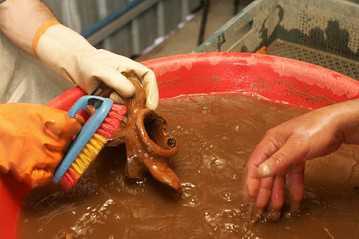Turkey’s new underground rail network harnessed cutting-edge engineering technology to connect Europe and Asia under the waters of Istanbul. But the project has also literally unearthed Istanbul’s history, yielding surprises and challenging assumptions about one of the world’s greatest imperial cities.

Turkeys new underground rail network has unearthed some 35,000 artifacts
The $2.8 billion megaproject built by a Turkish-Japanese consortium offered an opportunity for archaeologists to conduct excavations of unprecedented scale across Istanbul, allowing them to reach under the surface of previously off-limits business and residential districts. At times, tensions have flared between government officials frustrated with project delays and archeologists calling for sensitivity toward the city’s storied heritage.
Some of the 35,000 artifacts unearthed during the excavation are planned to be presented to the public in an ambitious outdoor museum project called Archeopark. Archaeologists are still not finished excavating and cataloguing artifacts, according to Istanbul Archaeological Museums, which is leading the project.
Here’s some of the most eye-catching findings:
The excavation showed Istanbul to be thousands of years older than the historians had thought. Still a decade ago, the city was widely accepted to be 2,700 years old, but human remains and artifacts found proved the city’s history dates back at least 8,500 years ago, to the New Stone Age. Early this year, in Pendik, at the Asian end of the under-construction metro network, archaeologists unearthed a complete village from that period.
The largest harbor of the early Byzantine period – the Port of Theodosius – was also resurfaced thanks to the Marmaray project. The location of the port – which was thought to once be the world’s largest – was roughly known, situated in the densely populated area of today’s Yenikapi, but the findings allowed experts to draw a much more detailed map of the early Byzantine-era Istanbul, called Byzantion at the time.
Archaeologists found dozens of well-preserved ancient vessels, some 15 meters long and 5 meters wide, which shed light on the city’s maritime history, ship construction and trade, as well as the city’s links with the outer world, according Istanbul Archaeological Museums. Cemal Pulak, a maritime archaeologist from Texas A&M University, said that after the ships were resurfaced in 2005, excavators struggled to keep the vessels moist and not allow them dry up and crumble apart “as biscuits dipped in a cup of tea.”
via Istanbul Metro Project Digs Up Historical Surprises – Middle East Real Time – WSJ.
